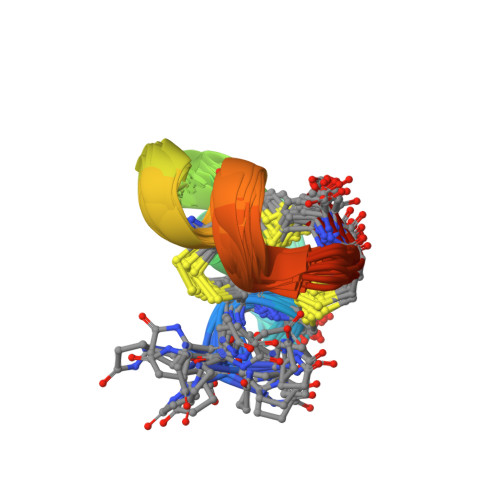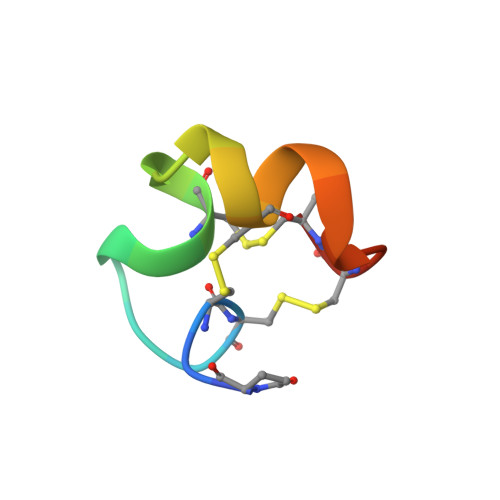A Novel Mu-Conopeptide, Cniiic, Exerts Potent and Preferential Inhibition of Na(V) 1.2/1.4 Channels and Blocks Neuronal Nicotinic Acetylcholine Receptors.
Favreau, P., Benoit, E., Hocking, H.G., Carlier, L., D'Hoedt, D., Leipold, E., Markgraf, R., Schlumberger, S., Cordova, M.A., Gaertner, H., Paolini-Bertrand, M., Hartley, O., Tytgat, J., Heinemann, S.H., Bertrand, D., Boelens, R., Stocklin, R., Molgo, J.(2012) Br J Pharmacol 166: 1654
- PubMed: 22229737
- DOI: https://doi.org/10.1111/j.1476-5381.2012.01837.x
- Primary Citation of Related Structures:
2YEN - PubMed Abstract:
The µ-conopeptide family is defined by its ability to block voltage-gated sodium channels (VGSCs), a property that can be used for the development of myorelaxants and analgesics. We characterized the pharmacology of a new µ-conopeptide (µ-CnIIIC) on a range of preparations and molecular targets to assess its potential as a myorelaxant. µ-CnIIIC was sequenced, synthesized and characterized by its direct block of elicited twitch tension in mouse skeletal muscle and action potentials in mouse sciatic and pike olfactory nerves. µ-CnIIIC was also studied on HEK-293 cells expressing various rodent VGSCs and also on voltage-gated potassium channels and nicotinic acetylcholine receptors (nAChRs) to assess cross-interactions. Nuclear magnetic resonance (NMR) experiments were carried out for structural data. Synthetic µ-CnIIIC decreased twitch tension in mouse hemidiaphragms (IC(50) = 150 nM), and displayed a higher blocking effect in mouse extensor digitorum longus muscles (IC = 46 nM), compared with µ-SIIIA, µ-SmIIIA and µ-PIIIA. µ-CnIIIC blocked Na(V)1.4 (IC(50) = 1.3 nM) and Na(V)1.2 channels in a long-lasting manner. Cardiac Na(V)1.5 and DRG-specific Na(V)1.8 channels were not blocked at 1 µM. µ-CnIIIC also blocked the α3β2 nAChR subtype (IC(50) = 450 nM) and, to a lesser extent, on the α7 and α4β2 subtypes. Structure determination of µ-CnIIIC revealed some similarities to α-conotoxins acting on nAChRs. µ-CnIIIC potently blocked VGSCs in skeletal muscle and nerve, and hence is applicable to myorelaxation. Its atypical pharmacological profile suggests some common structural features between VGSCs and nAChR channels.
Organizational Affiliation:
Atheris Laboratories, Bernex-Geneva, Switzerland.

















